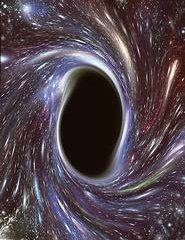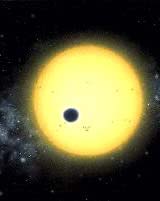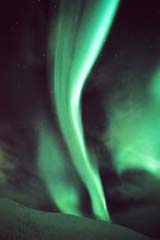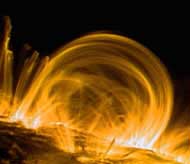Physics and Astronomy
This area deals with the fundamental laws and building blocks of nature and how they interact, the properties and the behavior of matter, and research into space and time and their structures.
innovations-report provides in-depth reports and articles on subjects such as astrophysics, laser technologies, nuclear, quantum, particle and solid-state physics, nanotechnologies, planetary research and findings (Mars, Venus) and developments related to the Hubble Telescope.

Event horizon dawns on desktop
Miniature physics phenomena could show hidden shades of space.
An event horizon is dawning in laboratories. Using frozen light, physicists hope to mimic this peculiar cosmic phenomenon and glimpse something like the belches of a black hole.
At the event horizon – the rim of a voracious black hole – dimensions as we know them disappear. To an observer on a spaceship, light and time appear to stand still. A floating spaceman would seem to slow and stop.
“It’s very d

Gravity leaps into quantum world
Researchers finally measure the subtle quantum effects of fourth fundamental force.
Far from falling smoothly, objects moving under gravity do so in lurching, quantum leaps, a French experiment has revealed 1 . The finding confirms that gravity, like the Universe’s three other fundamental forces, can have a quantum effect.
Particles, such as electrons confined to their orbital shells around the nucleus of an atom, are restricted by the rules of quantum mechan

Planet hunters pledge Eddington support
Belt tightening cloud could have silver-lining for Europe’s planet hunters
European planet hunters are rallying round a beleaguered effort to launch the first spacecraft that might detect Earth-like planets beyond our own Solar System. Meeting in London last week they agreed that the low-cost, low-risk mission has a lot to offer.
The planet-spotting mission Eddington has been approved by the European Space Agency (ESA), but is currently on hold awaiting funds; unless they ma

Good news: How the Earth will survive when the Sun becomes a supergiant
The astronomy textbooks will have to be rewritten, say astrophysicists at the University of Sussex who have re-examined standard calculations about solar evolution and the distant future of the Earth.
The textbooks tell us that one day the Sun will burn up its nuclear fuel and expand to an enormous size, finally engulfing its inner planets including Earth. However, using the latest data based on real stars, the University of Sussex researchers suggest a (slightly) less catastrophic future f

Unveiling the aurora
Satellites have detected the shifting forces that weave the Northern Lights.
A group of four spacecraft has given scientists their first glimpse of the immense electrical circuit above the Earth that creates the shimmering veil of the aurora borealis, or Northern Lights 1 .
In January 2001 the four satellites of the European Space Agency’s Cluster mission encountered a beam of electrons moving away from the Earth near the North Pole. The beam was on the outwa

Space weather forecast step closer
American Geophysical Society Meeting, San Francisco, December 2001
The Sun’s violent outbursts have deep and twisted origins.
The Sun’s violent eruptions of material and magnetic energy have deep and twisted origins, researchers told this week’s American Geophysical Union Meeting in San Francisco, California.
These coronal mass ejections (CMEs) cause the aurora, seen at the Earth’s poles, and can knock out spacecraft. An understanding of what drives CMEs may one da